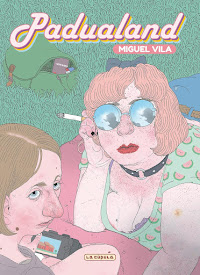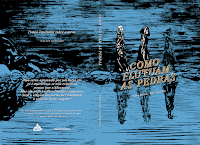
‘Say the types again.’
‘Responsible-parent genius-parent genius-child clown-child.’
‘Okay, do Star Wars.’
‘Luke Paul, Han Solo John, Chewbacca George, the robots Ringo.’
And so they go on. But if such a basic human formation is true, if it makes up an actual archetype, would there be room for a fifth member?
The history of The Beatles is well known, and “fifth Beatle” has already become an expression on its own in the English language, standing for an ellusive complement to an already perfect arrangement of elements. Necessary? Perhaps not. But its inclusion, even if virtual, becomes a base for reflection, the dreams of history, and for the nostalgia of that which would never be. As the subtitle of this book proclaims - The Story of Astrid Kirchherr & Stuart Sutcliffe -, the events portrayed are disclosed within a few months. 18 months, to be precise, from October 1960, when the group that would eventually become The Beatles was only a rock’n’roll hired band in a seedy bar, in the seedy streets of Hamburg, by the infamous Reeperbahn (where “The memories are short but the tales are long”, sings Tom Waits), until April 1962, Sutcliffe’s death. A death that would mark not only the end, of course (of Stuart’s life, his engagement to Astrid, the path of an emerging visual artist, a moment in time) but also a beginning (the adulthood of The Beatles, and the emergence of an era, which Jon Savage, in an excerpt included in this edition, calls “Pop Modernism", the turn of a page in time and a fashion that would brand the years to come and still ellicits awe today). The Beatles are not the centre of the book, although they may act as a surplus of attention, a sort of decentred hub. Their story in Hamburg is fairly well-known, and this is not what the book is about “the [first and original] fifth Beatle”, but about the love that blossomed between the not-so-great bass player but artistically and intellectually curious Sutcliffe and the magnetic young photographer Kirchherr.
As the subtitle of this book proclaims - The Story of Astrid Kirchherr & Stuart Sutcliffe -, the events portrayed are disclosed within a few months. 18 months, to be precise, from October 1960, when the group that would eventually become The Beatles was only a rock’n’roll hired band in a seedy bar, in the seedy streets of Hamburg, by the infamous Reeperbahn (where “The memories are short but the tales are long”, sings Tom Waits), until April 1962, Sutcliffe’s death. A death that would mark not only the end, of course (of Stuart’s life, his engagement to Astrid, the path of an emerging visual artist, a moment in time) but also a beginning (the adulthood of The Beatles, and the emergence of an era, which Jon Savage, in an excerpt included in this edition, calls “Pop Modernism", the turn of a page in time and a fashion that would brand the years to come and still ellicits awe today). The Beatles are not the centre of the book, although they may act as a surplus of attention, a sort of decentred hub. Their story in Hamburg is fairly well-known, and this is not what the book is about “the [first and original] fifth Beatle”, but about the love that blossomed between the not-so-great bass player but artistically and intellectually curious Sutcliffe and the magnetic young photographer Kirchherr.
In a few exchanged emails, Arne Bellstorf explained: “The conversations with Astrid took place during a few afternoons. I guess it was just a few hours before I started working on the storyboard. As for the ‘facts’ I tried to stick to Astrid’s version of the events, since it is her story. I read a lot about the Beatles in Hamburg and had a kind of timeline: when they arrived, when they switched to the Top Ten, when they had their first recording sessions etc., but for the rest of the book, the mood and atmosphere, everything regarding the art school pupils (the ‘existentialists‘), I simply included a few photographs and Astrid's anecdotes”. And in fact, throughout the book we feel that the author is less interested in reconstructing the historical events - although he does present them - than the mood and the cumplicity of the main characters. For the most part, Baby’s in Black is a straightforward, realist account of things, but the narrative is interspersed now and then by a recurrent dream sequence, visually based on the most famous Kirchherr’s self-portrait: in front of a mirror, she stands behind her Rolleicord, and above her, some branches reach down towards her, like slow black ink in water, a dubious shadow. The dream shows a small forest with bare trees, Astrid walking amongst them, and a black scarf floating by and getting caught in the branches. Later on, after she meets Stuart, the dream also becomes a daydream fantasy (actually, night, but okay), with Stuart walking with her, kissing her, the scarf tight around his neck, and Elvis’ Love me Tender playing as the soundtrack. By the end of the book, Astrid finds herself alone again in the forest, the scarf once again caught around the branches, and a mirror reflecting her face. These scenes stand as a poetical sign of Stuart’s and Astrid’s bond, as fleeting as it was powerful, perhaps even more powerful because it was fleeting, and therefore becoming a fantasmatic bliss, frozen perfect forever.
For the most part, Baby’s in Black is a straightforward, realist account of things, but the narrative is interspersed now and then by a recurrent dream sequence, visually based on the most famous Kirchherr’s self-portrait: in front of a mirror, she stands behind her Rolleicord, and above her, some branches reach down towards her, like slow black ink in water, a dubious shadow. The dream shows a small forest with bare trees, Astrid walking amongst them, and a black scarf floating by and getting caught in the branches. Later on, after she meets Stuart, the dream also becomes a daydream fantasy (actually, night, but okay), with Stuart walking with her, kissing her, the scarf tight around his neck, and Elvis’ Love me Tender playing as the soundtrack. By the end of the book, Astrid finds herself alone again in the forest, the scarf once again caught around the branches, and a mirror reflecting her face. These scenes stand as a poetical sign of Stuart’s and Astrid’s bond, as fleeting as it was powerful, perhaps even more powerful because it was fleeting, and therefore becoming a fantasmatic bliss, frozen perfect forever.
It is a book of ghosts, of course, of mirrors and smoke, corroborated with a final quote from Cocteau’s Orpheus. But ghosts whose presence serves for the purpose of underlining the importance and gravitas of their swift passage. To some extent, and thinking within the medium of comics, the very opening of Grant Morrison’s The Invisibles saga also calls forth the ghosts of John Lennon and Stuart Sutcliffe to push its own story forward. In the case of this book, there is a strange, eulegistic tone, both sad and wonderful at the same time, underlined by the very material qualities of Bellstorf’s art in this particular project. This is a magnificent balance between line work and charcoal pencils.
In accordance to the culture of the times, there are many scenes of people smoking everywhere, and even though the lines of the smoke are slightly different from the other objects’, places’ and characters’, these lines go beyond mere representation and are extended throughout the book as its basic, uncategorized matter. The black is alive and slowly dissolves everything into itself. Even life. Even love.
Most of the page’s composition opts for a simple approach: regular 2 x 3 grids, with many variations consisting in the fusion of two panels into one long horizontal one. Sometimes a page may only contain three of these longer panels, but they are used to depict the aspects of an ambient, whether with characters represented in them or not, the latter case to create establishing shots, the former for a better comprehension of the placement of the characters. The author also chooses more often than not mid shots and close-ups, framing the characters so that most of what surrounds them is almost eclipsed, so that we concentrate on their exchanges, expressions and body language. Although Bellstorf has a cartoonish style, the lively, look-alike expressions of his characters are dead-on, which is especially visible in the more recognizable faces (Paul McCartney’s and John Lennon’s). However, his silent, de-centered panels - used to depict the scenes in which Stuart is painting, for instance - or the extreme close-ups - for intense scenes, only underline the effective difference of that choice, making them even more intensive. Here and there, the panel’s borders lose their straight lines due to the overwhelming balloons with the lyrics of the blaring songs that traverse the space.

Stuart’s death happens “off-stage”, if we can say it in this way. It happens and resonates through six pages in which sound - as it is rendered in comics, through speech balloons and onomatopoeias (wholly absent from this book) - increasingly disappears, first with emptied balloons, then with awkward perspectives, and then with no characters… One last page shows Astrid meeting John and Paul at the airport. John asks, “Where’s Stuart?”, but no answer is given.
One of Gréco’s most famous songs is the one written by Jacques Prévert, Les Feuilles Mortes. In it, one verse goes: “Mais la vie sépare ceux qui s’aiment,/ Tout doucement, sans faire de bruit” [“But life pulls those who love each other apart, so sweetly, in silence]. Perhaps Bellstorf is following that lesson in this final moment. Its painful silence is much more powerful than melodramatic screams.
A thank you to the publisher, for sending me a review copy.
Nota: este texto foi escrito originalmente em inglês, a pedido da editora; agradecimentos a Miriam Sampaio, pela revisão.
10 de outubro de 2011
Baby's in Black. Arne Bellstorf (Self-made Hero)
Publicada por
Pedro Moura
à(s)
12:15 p.m.
![]()
Etiquetas: Alemanha
Subscrever:
Enviar feedback (Atom)


















Sem comentários:
Enviar um comentário